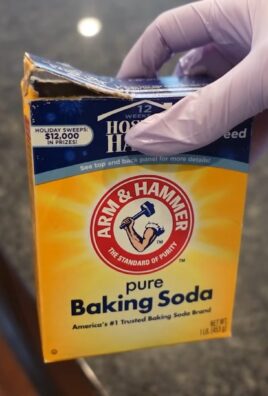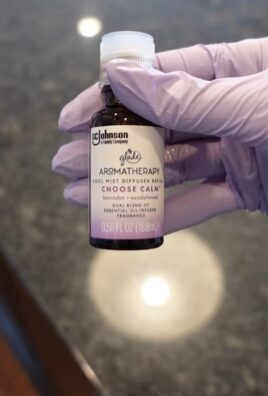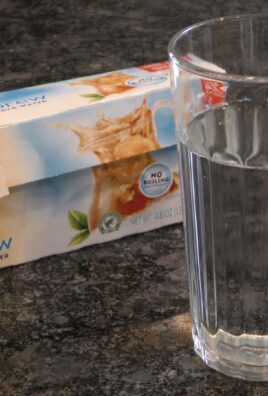Baking Soda Uses That Work: Unlock the Secret Weapon in Your Home!
Have you ever looked at that box of baking soda in your pantry and wondered if it could do more than just help your cookies rise? I know I have! For generations, baking soda, also known as sodium bicarbonate, has been a staple in kitchens worldwide. From ancient Egyptians using natron (a naturally occurring form of baking soda) for cleaning and mummification to its modern-day applications, this humble powder boasts a surprisingly rich history. But beyond its culinary roots, baking soda is a powerhouse of DIY potential, offering a plethora of solutions for everyday problems.
In this article, I’m going to share some incredible baking soda uses that work like magic! We’re diving deep into the world of DIY hacks, revealing how this inexpensive and readily available ingredient can revolutionize your cleaning routine, enhance your beauty regimen, and even improve your garden. Forget harsh chemicals and expensive products; baking soda is your eco-friendly, budget-friendly answer to a cleaner, healthier, and happier home. So, grab that box of baking soda, and let’s get started on this exciting journey of discovery!

Unlocking the Magic: Unexpected Baking Soda Hacks That Will Simplify Your Life
Hey there, fellow DIY enthusiasts! I’m always on the lookout for simple, effective solutions to everyday problems, and baking soda has consistently proven to be a true champion. Forget those expensive, specialized cleaners and gadgets – this humble pantry staple can tackle a surprising number of tasks around your home. I’m going to share some of my favorite baking soda hacks that have genuinely made my life easier. Get ready to be amazed!
Deodorizing Like a Pro
Baking soda is a natural odor absorber, making it a fantastic alternative to chemical-laden air fresheners. Here’s how I use it to keep my home smelling fresh:
* Refrigerator Refresh: Place an open box of baking soda in your fridge to neutralize food odors. I usually replace it every three months for optimal effectiveness.
* Stinky Shoes Savior: Sprinkle baking soda inside your shoes after each wear to absorb moisture and prevent odors. Shake it out before wearing them again.
* Carpet Cleaner Extraordinaire: Sprinkle baking soda liberally over your carpets, let it sit for at least 15 minutes (or even overnight for stubborn odors), and then vacuum thoroughly. This works wonders on pet odors and general mustiness.
* Garbage Disposal Deodorizer: Pour 1/2 cup of baking soda down your garbage disposal, followed by hot water. This will help eliminate unpleasant smells and keep your disposal running smoothly.
* Litter Box Odor Control: Sprinkle a layer of baking soda at the bottom of your cat’s litter box before adding the litter. This will help absorb odors and keep your home smelling fresh.
Cleaning Powerhouse
Baking soda’s mild abrasive properties make it an excellent cleaning agent for a variety of surfaces. Just remember to test it on an inconspicuous area first, especially on delicate materials.
* All-Purpose Cleaner: Mix baking soda with water to create a paste. Use this paste to scrub sinks, countertops, bathtubs, and other surfaces. Rinse thoroughly with water.
* Oven Cleaner: Make a paste of baking soda and water, and spread it all over the inside of your oven. Let it sit overnight, then scrub away the grime with a sponge.
* Microwave Cleaner: Place a bowl of water with a tablespoon of baking soda in your microwave and heat for a few minutes until the water steams up. Then, simply wipe down the inside of the microwave with a cloth.
* Grout Cleaner: Mix baking soda with a little bit of water to form a paste. Apply the paste to the grout lines, let it sit for a few minutes, and then scrub with an old toothbrush. Rinse with water.
* Burnt Food Savior: Sprinkle baking soda in the bottom of a pot or pan with burnt food. Add water and let it simmer for a few minutes. The baking soda will help loosen the burnt food, making it easier to scrub away.
* Coffee and Tea Stain Remover: Use a paste of baking soda and water to scrub away coffee and tea stains from mugs and teapots.
* Silver Polish: Make a paste of three parts baking soda to one part water. Gently rub the paste onto your silver items with a soft cloth, then rinse with water and dry thoroughly.
* Toothbrush Cleaner: Soak your toothbrush in a solution of baking soda and water to help remove bacteria and keep it fresh.
DIY Beauty Treatments
Believe it or not, baking soda can also be used in a variety of DIY beauty treatments. Again, it’s crucial to test on a small area first, as it can be irritating for some skin types.
* Exfoliating Scrub: Mix baking soda with water to create a gentle exfoliating scrub for your face and body. Massage it onto your skin in circular motions, then rinse with water.
* Teeth Whitener: Mix baking soda with a small amount of water to create a paste. Use this paste to brush your teeth once or twice a week to help whiten them. Be careful not to overdo it, as it can erode enamel.
* Deodorant: Apply a small amount of baking soda under your arms as a natural deodorant.
* Foot Soak: Add a few tablespoons of baking soda to a warm foot bath to soothe tired feet and soften calluses.
* Acne Treatment: Make a paste of baking soda and water and apply it to pimples as a spot treatment. Let it sit for a few minutes, then rinse with water.
Gardening Helper
Baking soda can also be a valuable tool in the garden.
* Tomato Sweetener: Sprinkle a small amount of baking soda around your tomato plants to help reduce acidity in the soil and make your tomatoes sweeter.
* Fungicide: Mix baking soda with water and a small amount of liquid soap to create a natural fungicide for your plants. Spray the solution on affected areas.
* Weed Killer: Sprinkle baking soda directly onto weeds to kill them. Be careful not to get it on your desired plants, as it can harm them as well.
* Clean Garden Tools: Use a paste of baking soda and water to clean your garden tools and remove rust.
Specific Project: DIY Baking Soda Volcano
Okay, let’s get into a fun project that’s both educational and entertaining: building a baking soda volcano! This is a classic science experiment that’s perfect for kids (and adults who are young at heart).
Materials You’ll Need:
* Empty plastic bottle (a soda bottle works great)
* Baking soda
* Vinegar
* Dish soap
* Water
* Red food coloring (optional)
* Construction paper, cardboard, or clay for the volcano structure
* Spoon or measuring cup
Building the Volcano Structure:
1. Choose Your Base: Start by selecting a base for your volcano. A piece of cardboard or a sturdy plate will work well. This will catch any overflow from the eruption.
2. Position the Bottle: Place the empty plastic bottle in the center of your base. This will be the “crater” of your volcano.
3. Create the Cone Shape: Now, it’s time to build the volcano’s cone. You can use a variety of materials for this.
* Construction Paper Method: Roll a large piece of construction paper into a cone shape, leaving the top open to fit around the bottle’s opening. Secure the paper with tape or glue.
* Cardboard Method: Cut out several cardboard triangles and tape them together to form a cone shape around the bottle.
* Clay Method: If you have modeling clay, you can mold it around the bottle to create a more realistic volcano shape. This is a bit more time-consuming, but it can look really impressive.
4. Secure the Structure: Once you’ve created the cone, make sure it’s securely attached to the base and the bottle. Use tape, glue, or clay to reinforce the structure.
5. Decorate (Optional): Now comes the fun part! Decorate your volcano to make it look more realistic. You can use paint, markers, or even small rocks and plants to add details.
Creating the Eruption:
1. Prepare the Mixture: In a separate cup, mix together about 1/2 cup of vinegar, a squirt of dish soap, and a few drops of red food coloring (if desired). The dish soap will help create more foam in the eruption, and the food coloring will make it look more like lava.
2. Add Baking Soda to the Bottle: Pour about 2 tablespoons of baking soda into the plastic bottle inside the volcano.
3. Get Ready to Erupt!: Now for the exciting part! Quickly pour the vinegar mixture into the bottle with the baking soda.
4. Watch the Eruption: Stand back and watch as the baking soda and vinegar react, creating a foamy “lava” eruption that spills out of the volcano’s crater!
5. Repeat the Fun: You can repeat the eruption as many times as you like by adding more baking soda and vinegar.
This baking soda volcano is a great way to teach kids about chemical reactions in a fun and engaging way. Plus, it’s just plain cool to watch!
I hope these baking soda hacks inspire you to explore the many uses of this amazing ingredient. It’s a versatile, affordable, and eco-friendly way to tackle a variety of tasks around your home. Happy experimenting!

Conclusion
So, there you have it! Unlocking the power of baking soda goes far beyond just leavening your favorite cakes. We’ve explored a range of practical and cost-effective applications that can simplify your life and save you money. From tackling stubborn stains to creating natural beauty remedies, the versatility of this humble ingredient is truly remarkable.
Why is this DIY approach a must-try? Because it empowers you to take control of your cleaning, beauty, and even health routines using a safe, readily available, and environmentally friendly alternative to harsh chemicals and expensive products. Imagine the satisfaction of knowing you’re reducing your exposure to potentially harmful substances while simultaneously saving money. That’s the power of baking soda!
But the possibilities don’t stop here. Feel free to experiment and adapt these techniques to suit your specific needs and preferences. For instance, if you’re using baking soda as a facial scrub, try adding a drop or two of your favorite essential oil for added fragrance and therapeutic benefits. Lavender, tea tree, and chamomile are all excellent choices. Or, if you’re using it to deodorize your refrigerator, consider placing a small bowl of baking soda mixed with a few drops of lemon juice for an extra burst of freshness.
For cleaning grout, you can make a paste of baking soda and hydrogen peroxide for a powerful whitening effect. Let it sit for a few minutes before scrubbing and rinsing. If you’re dealing with particularly stubborn stains on your clothes, try pre-soaking them in a solution of baking soda and water before washing.
Remember, the key to success with these DIY tricks is consistency and patience. Don’t expect miracles overnight, but with regular use, you’ll be amazed at the positive impact baking soda can have on your home and well-being.
We’re confident that once you experience the benefits of these baking soda uses firsthand, you’ll be hooked. So, go ahead, give them a try! We encourage you to start with one or two of the techniques that resonate most with you and gradually incorporate more into your routine.
And most importantly, we want to hear about your experiences! Share your successes, challenges, and any variations you discover in the comments section below. Let’s create a community where we can all learn from each other and unlock the full potential of this amazing ingredient. What are you waiting for? Dive into the world of **baking soda uses** and discover the difference it can make in your life!
Frequently Asked Questions
Is baking soda safe to use on all surfaces?
While baking soda is generally considered safe and gentle, it’s always a good idea to test it on an inconspicuous area first, especially when cleaning delicate surfaces like polished wood or certain types of stone. Baking soda is mildly abrasive, so excessive scrubbing on soft materials could potentially cause scratches. Avoid using baking soda on aluminum, as it can cause discoloration. For surfaces you’re unsure about, consult the manufacturer’s recommendations or test a small area first.
Can I use baking soda internally?
While some people use baking soda internally for various reasons, such as to alkalize the body or relieve heartburn, it’s crucial to consult with a healthcare professional before doing so. Baking soda can interact with certain medications and may not be suitable for individuals with certain medical conditions, such as kidney problems or high blood pressure. Excessive consumption of baking soda can also lead to electrolyte imbalances and other health issues. Always prioritize your health and safety by seeking professional medical advice before using baking soda internally.
How long does baking soda last?
Unopened baking soda has an indefinite shelf life when stored in a cool, dry place. However, once opened, it’s best to use it within six months to a year for optimal leavening power in baking. While it may still be effective for cleaning and deodorizing purposes after that, its ability to react with acids and produce carbon dioxide (which is essential for baking) may diminish over time. To test the potency of your baking soda, mix a small amount with vinegar. If it fizzes vigorously, it’s still good to use. If not, it’s time to replace it.
Can baking soda be used to treat acne?
Baking soda is sometimes touted as a remedy for acne due to its exfoliating and anti-inflammatory properties. However, it’s important to exercise caution when using baking soda on your skin, especially if you have sensitive skin. Baking soda has a high pH level, which can disrupt the skin’s natural pH balance and lead to irritation, dryness, and even breakouts. If you choose to try baking soda for acne, use it sparingly and dilute it with water to create a mild paste. Apply it to affected areas for a short period of time (no more than a few minutes) and rinse thoroughly. Monitor your skin for any signs of irritation and discontinue use if necessary. There are many other acne treatments available that are specifically formulated for sensitive skin and are less likely to cause adverse reactions. Consulting a dermatologist is always the best approach for managing acne effectively.
What’s the difference between baking soda and baking powder?
Baking soda (sodium bicarbonate) and baking powder are both leavening agents used in baking, but they work differently. Baking soda requires an acidic ingredient, such as vinegar, lemon juice, or buttermilk, to activate and produce carbon dioxide, which makes baked goods rise. Baking powder, on the other hand, contains both an acid and a base, so it doesn’t need an additional acidic ingredient to work. There are two types of baking powder: single-acting and double-acting. Single-acting baking powder releases carbon dioxide as soon as it’s mixed with liquid, while double-acting baking powder releases carbon dioxide in two stages: once when mixed with liquid and again when heated in the oven. It’s important to use the correct leavening agent in your recipes to achieve the desired results. Substituting one for the other can result in flat or dense baked goods.
How can I use baking soda to remove odors from my carpets?
Baking soda is an excellent natural deodorizer for carpets. Simply sprinkle a generous amount of baking soda evenly over the carpet, let it sit for at least 30 minutes (or even overnight for stubborn odors), and then vacuum it up thoroughly. The baking soda will absorb odors and leave your carpet smelling fresh and clean. For extra deodorizing power, you can add a few drops of your favorite essential oil to the baking soda before sprinkling it on the carpet. Lavender, eucalyptus, and tea tree oil are all good choices. Be sure to test the essential oil on a small, inconspicuous area of the carpet first to ensure it doesn’t cause any discoloration.




Leave a Comment